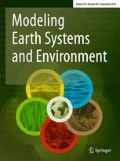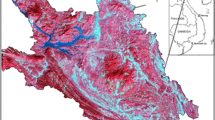Abstract
This paper focuses on the quantitative modeling of desertification in Morocco’s Middle Atlas regions, Ain Nokra Forest. In order to map the degree of desertification in the forest in 2021, this study used Sentinel-2A images. More precisely, the spectral indices, such as the NDVI, albedo, and TCT indices, have first been calculated. After putting different combinations through a linear regression analysis, the feature space was created using the correlation ratio that is the most negative of these indices (NDVI–albedo, TCG–TCB, and TCW–TCB). With a correlation ratio of − 0.80, the TCG–TCB combination is the best, followed by the NDVI–albedo ratio, which has a correlation ratio of − 0.63. A desertification map for the entire forest has been created as a result of the first combination being used to propose the Desertification Degree Index (DDI). There are currently five categories of desertification (extreme, severe, moderate, low, and non-desertification). according to our model, the forest is progressively desertifying. Typically, 40% of the forest area is classified as having severe to intense desertification, while 51% is classified as having weak to moderate desertification. However, only 8.52% of the region is deemed to be “non-desertified”. Finally, due to its incredibly high overall accuracy of 88.32%, the model is almost optimal for quantitative analysis and monitoring of desertification in the Moroccan Middle Atlas.











Similar content being viewed by others
References
Afrasinei GM, Melis MT, Buttau C, Arras C, Pistis M, Zerrim A, Guied M, Ouessar M, Essifi B, Zaied MB, Jlali A, Jarray H, Ghiglieri G (2017) Classification methods for detecting and evaluating changes in desertification-related features in arid and semiarid environments. Euro-Mediterr J Environ Integr 2(1):1–19. https://doi.org/10.1007/S41207-017-0021-1/FIGURES/8
Amrani S (2016) Hydrodynamisme, hydrogéochimie et vulnérabilité de la nappe d’eau superficielle et leur relation avec la tectonique cassante dans la zone effondrée Timahdite—Almis Guigou ( Moyen Atlas, Maroc)—Sécheresse info [Université Sidi Mohamed Ben Abdellah, Fès,]. http://www.secheresse.info/spip.php?article84564
Badreldin N, Xing Z, Goossens R (2017a) The application of satellite-based model and bi-stable ecosystem balance concept to monitor desertification in arid lands, a case study of Sinai Peninsula. Model Earth Syst Environ 3(1):1–16. https://doi.org/10.1007/S40808-017-0300-5
Badreldin N, Xing Z, Goossens R (2017b) The application of satellite-based model and bi-stable ecosystem balance concept to monitor desertification in arid lands, a case study of Sinai Peninsula. Model Earth Syst Environ 3(1):1–16. https://doi.org/10.1007/S40808-017-0300-5/METRICS
Becerril-Piña R, Díaz-Delgado C, Mastachi-Loza CA, González-Sosa E (2016) Integration of remote sensing techniques for monitoring desertification in Mexico. Hum Ecol Risk Assess J 22(6):1323–1340. https://doi.org/10.1080/10807039.2016.1169914
Bengrich M (1988) La désertification dans le bassin de Guercif (Maroc oriental) : étude de géographie physique—Sécheresse info. Avignon. http://www.secheresse.info/spip.php?article7744
Bouabid R, Rouchdi M, Badraoui M, Diab A, Louafi S (2010) Assessment of Land Desertification Based on the MEDALUS Approach and Elaboration of an Action Plan: The Case Study of the Souss River Basin, Morocco. Land Degrad Desertification Assess Mitig Remediat. https://doi.org/10.1007/978-90-481-8657-0_10
Chen C, Bu J, Zhang Y, Zhuang Y, Chu Y, Hu J, Guo B (2019) The application of the tasseled cap transformation and feature knowledge for the extraction of coastline information from remote sensing images. Adv Space Res 64(9):1780–1791. https://doi.org/10.1016/J.ASR.2019.07.032
Díaz S, Purvis A, Cornelissen JHC, Mace GM, Donoghue MJ, Ewers RM, Jordano P, Pearse WD (2013) Functional traits, the phylogeny of function, and ecosystem service vulnerability. Ecol Evol 3(9):2958. https://doi.org/10.1002/ECE3.601
Dregne HE (2010) Land degradation in the drylands. Arid Land Res Manag 16(2):99–132. https://doi.org/10.1080/153249802317304422
Drusch M, Del Bello U, Carlier S, Colin O, Fernandez V, Gascon F, Hoersch B, Isola C, Laberinti P, Martimort P, Meygret A, Spoto F, Sy O, Marchese F, Bargellini P (2012) Sentinel-2: ESA’s optical high-resolution mission for GMES operational services. Remote Sens Environ 120:25–36. https://doi.org/10.1016/J.RSE.2011.11.026
Fayech D, Tarhouni J (2021) Climate variability and its effect on normalized difference vegetation index (NDVI) using remote sensing in semi-arid area. Model Earth Syst Environ 7(3):1667–1682. https://doi.org/10.1007/S40808-020-00896-6/METRICS
El Hairchi K, Benbrahim Y, Ouiaboub L, Limame A (2022) Evaluation de l’effet des facteurs anthropiques sur la dégradation des forêts du Moyen atlas central (cas de la forêt Ain Nokra). Espace Géographique et Société Marocaine, 1(59). https://revues.imist.ma/index.php/EGSM/article/view/31805
El Hairchi K (2021) La dynamique des milieux forestiers dans le haut Guigou et gestion intégrée des ressources naturelles. Cas de la foret Ain Nokra (Moyen Atlas central—Sécheresse info [Sidi mohammed ben abdellah university]. http://www.secheresse.info/spip.php?article59960
Hui SR, Liu Q, Song Z, Tao GH (2011) The construction and application of an aledo–NDVI based desertification monitoring model. Procedia Environ Sci 10(1):2029–2035. https://doi.org/10.1016/J.PROENV.2011.09.318
IdéSoumaila K, Mohamed C, Mustapha N (2019) Water quality assessment using a new proposed water quality index: a case study from Morocco. Int J Environ Agric Biotechnol (IJEAB). https://doi.org/10.22161/ijeab.4411
Jiang Z, Huete AR (2010) Linearization of NDVI based on its relationship with vegetation fraction. Photogramm Eng Remote Sens 76(8):965–975. https://doi.org/10.14358/PERS.76.8.965
Jie C, Jing-zhang C, Man-zhi T, Zi-tong G (2002) Soil degradation: a global problem endangering sustainable development. J Geogr Sci 12(2):243–252. https://doi.org/10.1007/BF02837480
Jin S, Sader SA (2005) Comparison of time series tasseled cap wetness and the normalized difference moisture index in detecting forest disturbances. Remote Sens Environ 94(3):364–372. https://doi.org/10.1016/J.RSE.2004.10.012
Kauth R, Thomas G (1976) The tasselled cap—a graphic description of the spectral-temporal development of agricultural crops as seen by LANDSAT. LARS symposia. https://docs.lib.purdue.edu/lars_symp/159
Kumar BP, Babu KR, Rajasekhar M, Ramachandra M (2020) Identification of land degradation hotspots in semiarid region of Anantapur district, Southern India, using geospatial modeling approaches. Model Earth Syst Environ 6(3):1841–1852. https://doi.org/10.1007/S40808-020-00794-X/METRICS
Lahlaoi H, Rhinane H, Hilali A, Lahssini S, Moukrim S (2017) Desertification assessment using MEDALUS model in watershed Oued El Maleh, Morocco. Geosciences 7(3):50. https://doi.org/10.3390/GEOSCIENCES7030050
Lamaamri M, Lghabi N, Ghazi AK, El Harchaoui N, Adnan MSG, Shakiul Islam M (2022) Evaluation of desertification in the Middle Moulouya Basin (North-East Morocco) using sentinel-2 images and spectral index techniques. Earth Syst Environ 2022:1–20. https://doi.org/10.1007/S41748-022-00327-9
Lamqadem AA, Saber H, Pradhan B (2018a) Quantitative assessment of desertification in an arid oasis using remote sensing data and spectral index techniques. Remote Sens 10(12):1862. https://doi.org/10.3390/RS10121862
Liang S (2001) Narrowband to broadband conversions of land surface albedo I: algorithms. Remote Sens Environ 76(2):213–238. https://doi.org/10.1016/S0034-4257(00)00205-4
Liang S, Wang J (2019) Advanced remote sensing: terrestrial information extraction and applications. Adv Remote Sens Terr Inf Extr Appl. https://doi.org/10.1016/C2017-0-03489-4
Liu Q, Liu G, Huang C, Xie C (2015) Comparison of tasselled cap transformations based on the selective bands of Landsat 8 OLI TOA reflectance images. Int J Remote Sens 36(2):417–441. https://doi.org/10.1080/01431161.2014.995274
McCloy KR, Hall KA (2007) Mapping the density of woody vegetative cover using Landsat MSS digital data. Int J Remote Sens 12(9):1877–1885. https://doi.org/10.1080/01431169108955216
Ouazani EL, Khadija E-C, Abdelaziz E-B, Mhamed A (2020) LA CARTOGRAPHIE ET LA CARACTERISATION DE LA SENSIBILITE A LA DESERTIFICATION DANS LE BASSIN VERSANT DU HAUT OUERGHA (RIF CENTRAL-MAROC) PAR L’APPROCHE MEDALUS. Geomaghreb 20(16):16–2020. https://revues.imist.ma/index.php/Geomaghreb/article/view/30776
Salih A, Hassaballa AA, Ganawa E (2021) Mapping desertification degree and assessing its severity in Al-Ahsa Oasis, Saudi Arabia, using remote sensing-based indicators. Arab J Geosci 14(3):1–15. https://doi.org/10.1007/S12517-021-06523-7
Sayl KN, Sulaiman SO, Kamel AH, Muhammad NS, Abdullah J, Al-Ansari N (2021) Minimizing the impacts of desertification in an arid region: a case study of the West Desert of Iraq. Adv Civ Eng. https://doi.org/10.1155/2021/5580286
Seghir A, Mazoz L, Idrissi AJ (2019) Cartographie de sol dans la zone méridional de la plaine de Tafrata au Maroc Centro-Oriental et évaluation de leur sensibilité à la désertification. Revue Marocaine Des Sciences Agronomiques et Vétérinaires 7(2). https://www.agrimaroc.org/index.php/Actes_IAVH2/article/view/704
Thien BB, Phuong VT, Huong DTV (2022) Detection and assessment of the spatio-temporal land use/cover change in the Thai Binh province of Vietnam’s Red River delta using remote sensing and GIS. Model Earth Syst Environ 2022:1–12. https://doi.org/10.1007/S40808-022-01636-8
Zhao HL, Li J, Liu RT, Zhou RL, Qu H, Pan CC (2014) Effects of desertification on temporal and spatial distribution of soil macro-arthropods in Horqin sandy grassland, Inner Mongolia. Geoderma 223–225(1):62–67. https://doi.org/10.1016/J.GEODERMA.2014.01.026
Funding
The authors have not disclosed any funding.
Author information
Authors and Affiliations
Corresponding author
Ethics declarations
Conflict of interest
The authors declare that there is no conflict of interest.
Additional information
Publisher's Note
Springer Nature remains neutral with regard to jurisdictional claims in published maps and institutional affiliations.
Rights and permissions
Springer Nature or its licensor (e.g. a society or other partner) holds exclusive rights to this article under a publishing agreement with the author(s) or other rightsholder(s); author self-archiving of the accepted manuscript version of this article is solely governed by the terms of such publishing agreement and applicable law.
About this article
Cite this article
El Hairchi, K., Ben Brahim, Y., Ouiaboub, L. et al. Desertification modeling in the Moroccan Middle Atlas using Sentinel-2A images and TCT indexes (case of the Ain Nokra Forest). Model. Earth Syst. Environ. 9, 4279–4293 (2023). https://doi.org/10.1007/s40808-023-01752-z
Received:
Accepted:
Published:
Issue Date:
DOI: https://doi.org/10.1007/s40808-023-01752-z




